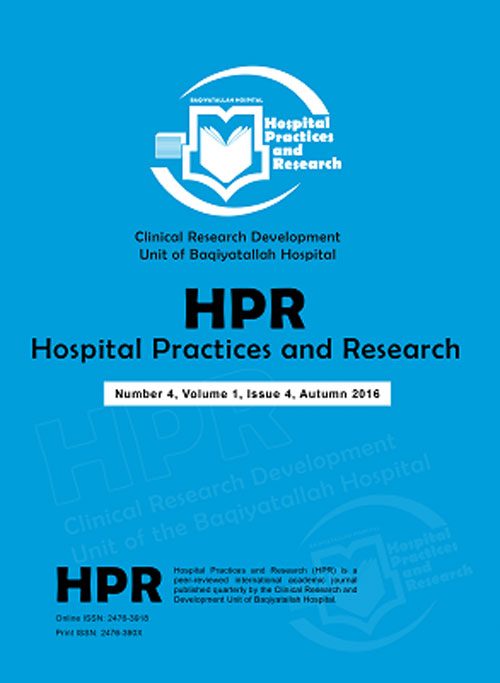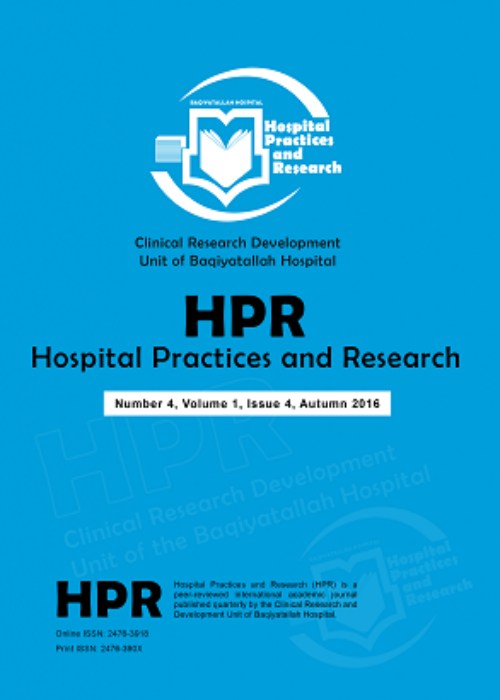فهرست مطالب

Hospital Practices and Research
Volume:1 Issue: 1, Winter 2016
- تاریخ انتشار: 1394/12/26
- تعداد عناوین: 8
-
Pages 3-7BackgroundPrimary hyperhidrosis (PH) refers to excessive sweating, beyond normal physiological levels, in specific sites of the body for unknown reasons. It is usually bilateral and is most prominent in the palms, axillae, feet, and face. PH prevalence is estimated to be 0%-6.1% in different populations. It usually begins in childhood and is more frequent in women. In 57% of cases, there is a positive family history. It is an autosomal dominant disorder with variable penetration in chromosomes 5, 14, or both.ObjectiveThe aim of this study was to illustrate current treatments of PH while focusing on surgical therapies through a narrative review.MethodsA complete search of online articles from 2007 to 2014 in PubMed, Scopus, and the Cochrane Library was performed. A free search and a search in the MeSH database for the studys keywords were also done. More than 600 relevant articles were found, of which 51 were chosen for this study. This article is based on those articles.ResultsSurgery is the best and more permanent therapy for PH. The most common consequences of surgery are compensatory sweating and gustatory sweating. There is controversy concerning whether lowering the level and limiting the number of ganglia on which surgery is performed reduces compensatory sweating.ConclusionIt seems that ramicotomy (selective division of the sympathetic postganglionic fibers) reduces compensatory sweating, but this theory should be confirmed with more studies.Keywords: Hyperhidrosis, Sweating, Sympathectomy, therapy, Operations
-
Pages 9-13BackgroundToday, in order to provide desirable health care services, too much emphasis is placed on the physical and mental health of nurses, and job burnout among nurses is introduced as harmful elements to the health of nurses.ObjectiveThis study was performed to evaluate job burnout in Shiraz Nemazee Hospital in relation to demographic characteristics.MethodsThis research is a cross-sectional and descriptive-analytic study. The research community included all nurses in the whole sections of Nemazee Hospital out of which 245 were selected by classified random sampling as the study sample. A questionnaire was used to collect the data. After collection, data were entered in statistical package for social sciences SPSS software (version 18) and T-test, and analysis of variance (ANOVA) and Kruskal-Wallis tests were used to analyze the variables.ResultsThe mean score of emotional exhaustion, lack of personal accomplishment and job burnout were at an average level, and depersonalization was at a low level. As regards the intensity of burnout, most nurses were moderate. Between components of depersonalization of job burnout with marital status and age, there was a significant relationship (PConclusionAccording to the findings of this study and in terms of the stressful nature of nursing profession, it is necessary that hospital managers and healthcare authorities pay attention to job burnout in nurses, its level, as well as provide and implement strategies for its prevention, thereby decreasing its effects and risks.Keywords: Burnout, nurses, Hospitals
-
Pages 15-19BackgroundIt is important to set up hospitals, since they play a key role in providing health care services based on the budget allocated to the health sector.ObjectiveThis study evaluated factors militating against the establishment of hospitals in Iran. It also emphasized the importance of health care services.MethodsThis cross-sectional study was conducted in 2012 using a qualitative approach. The study sample consisted of 22 people, officials, administrators and health experts who were recruited by purposeful selection. In order to collect data, a semi-structured interview was conducted. Data was analyzed using an Atlas-Ti software.ResultsAnalysis of the interviews suggest that the issue of providing services in terms of ease of access and equity in the allocation of health services is also the focus of particular attention. The socio-economic status of regions were examined in terms of the need for poverty alleviation, equity in health and well-being of interest to industry participants. The survey interviews revealed that the issue of financing and human resources for provincial hospitals, were the key challenges raised by participants in the study.ConclusionAccording to the findings of this study, feasibility studies and evidence-based management optimal decisions were adopted in order to build and operate hospitals in the provinces.Keywords: Establishment, Hospitals, Iran
-
Pages 21-25BackgroundChronic kidney disease is a health problem in todays world and hemodialysis is an alternative method for patients with chronic renal failure. Preparing provincial and national information on the situation of patients can play a significant role in improving the quality of services provided to patients undergoing hemodialysis.ObjectiveThis study aimed to investigate the characteristics of patients on dialysis in hemodialysis centers in Isfahan and some other centers (up to 30 km distant).MethodsThis cross-sectional study was conducted on 1,024 patients on dialysis in 13 dialysis centers in the early part of 2013. Studied variables were collected using a researcher-made questionnaire with Cronbach's alpha coefficient of 0.86. Data was analyzed using descriptive statistics and Chi-square test by SPSS version 22 software.ResultsThe results of 1024 patients undergoing hemodialysis includes the following: 60% (610 people) were male with a mean age of 54±17.67 years, and 92% (867 patients) had a private house. The family history of hemodialysis was positive in 24% (229 patients). In this study, 38% of patients (365 patients) were illiterate and the most common cause of kidney disease was diabetes in 42% (436) of the patients. Vascular access was venous-arterial fistula in 52% (519 people) with a mean hemodialysis of 52 months. Chronic renal failure was estimated at 300 per one million inhabitants in Isfahan Province (based on the last census in 2011 with the population estimated at 4,815,863 persons).ConclusionMajority of the studied population variables was somewhat similar to the studies conducted in other provinces; the only major difference was the most common cause of chronic renal failure leading to dialysis.Keywords: Demography, chronic renal failure, hemodialysis
-
Pages 27-31BackgroundThe quantity and quality of manpower, especially in health systems, are major factors affecting speed of service delivery, cost, and accuracy, or, in other words, the quality of service.ObjectiveThis study purposed to investigate the manpower required in various units of the laboratory at Shiraz Faghihi Hospital.MethodsThis is a cross-sectional and descriptive-analytical research conducted on all testing processes in the fields of parasitology, hormone biology, microbiology, and urinalysis performed at the studied hospital. The Westinghouse ergometer and timing method was used to estimate manpower requirements, and SPSS18 software was used to analyze data.ResultsThe average standard time of every duty cycle in parasitology units, hormone biology, microbiology, and urinalysis are 12, 5, 9, and 5 minutes, respectively. The numbers of human resources required in said units were estimated to be 2.6, 3, 4, and 3.7 respectively. In parasitology unit there is lack of 1 manpower. In hormone unit there are two manpower surpluses. In biology unit there is one manpower surplus and urinalysis unit is estimated to be proportional to the number of troops.ConclusionIt is suggested that new, scientific tools be used to evaluate the status of department staff and make improvements to avoid the high costs and difficulties that manpower shortages and surpluses cause for the organization.Keywords: Ergometer, Health Manpower, Laboratories, Hospital Units
-
Pages 33-36BackgroundA patient's satisfaction with nursing service is one of the main indices for measuring the quality and effectiveness of health care.ObjectiveThe purpose of this study was to investigate and compare patient's satisfaction with the nursing service provided in selected training hospitals in Tehran.MethodsThis cross-sectional study was conducted in 2013 using Patient's Satisfaction Standard questionnaire (PSI) in 7 selected training hospitals in Tehran. In this study, 336 patients discharged from 4 major units of each hospital namely internal, surgery, obstetrics and gynecology and pediatrics, were selected and studied randomly. Data were analyzed using the SPSS18 software.ResultsThe results of this study showed that the pediatric unit recorded maximum patients satisfaction with nursing care with a mean and SD of 3.78±0.68, while the surgery unit recorded minimum satisfaction with a mean and SD of 3.35±0.65. Also, a significant difference was observed between patient's satisfaction with nursing service in major units such as internal, surgery, obstetrics and pediatrics (P=0.015).ConclusionHowever, significant differences were found in terms of degree of satisfaction with nursing service between the major units of the hospitals. These differences may be due to the characteristics of providing care, unit, patient or family. Therefore, future research should be conducted in order to identify the cause of the difference in satisfaction between the different hospital units.Keywords: patients, satisfaction, Nursing Service, Hospitals
-
Pages 37-38IntroductionDiarrhea is one of the most common symptoms treated in general practice and gastroenterology. An estimated 1.7 billion cases of diarrhea are reported annually. Anxious and emotional persons are more sensitive to digestive problems. Anxious persons may feel their heartbeat and perceive their intestinal motility and spasm, and this may cause them more concern.Case PresentationIn this case report, a 31-year-old woman with chronic diarrhea and a stressed psyche is presented so as to emphasize the combination of organ disorders and psychiatric moods.ConclusionPatients suffering from chronic and persistence gastrointestinal disease should be evaluated by a psychiatrist. Psychotherapy and psych pharmacotherapy can greatly help the treatment of somatic complaints of these patients.Keywords: Gastrointestinal Disease, Emotions, anxiety, Diarrhea


